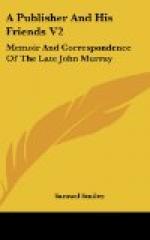At length, about the beginning of 1819, fourteen years after the project had been mentioned to Walter Scott, and about ten years after the book should have appeared, according to Campbell’s original promise, the “Essays and Selections of English Poetry” were published by Mr. Murray. The work was well received. The poet was duly paid for it, and Dr. Beattie, Campbell’s biographer, says he “found himself in the novel position of a man who has money to lay out at interest.” This statement must be received with considerable deduction, for, as the correspondence shows, Campbell’s pecuniary difficulties were by no means at an end.
It appears that besides the L1,000, which was double the sum originally proposed to be paid to Campbell for the “Selections,” Mr. Murray, in October 1819, paid him L200 “for books,” doubtless for those he had purchased for the “Collections,” and which he desired to retain.
We cannot conclude this account of Campbell’s dealing with Murray without referring to an often-quoted story which has for many years sailed under false colours. It was Thomas Campbell who wrote “Now Barabbas was a publisher,” whether in a Bible or otherwise is not authentically recorded, and forwarded it to a friend; but Mr. Murray was not the publisher to whom it referred, nor was Lord Byron, as has been so frequently stated, the author of the joke.
The great burden of the correspondence entailed by the Quarterly Review now fell on Mr. Murray, for Gifford had become physically incapable of bearing it. Like the creaking gate that hangs long on its hinges, Gifford continued to live, though painfully. He became gradually better, and in October 1816 Mr. Murray presented him with a chariot, by means of which he might drive about and take exercise in the open air. Gifford answered:
“I have a thousand thanks to give you for the pains you have taken about the carriage, without which I should only have talked about it, and died of a cold. It came home yesterday, and I went to Fulham in it. It is everything that I could wish, neat, easy, and exceedingly comfortable.”
Among the other works published by Mr. Murray in 1816 may be mentioned, “The Last Reign of Napoleon,” by Mr. John Cam Hobhouse, afterwards Lord Broughton. Of this work the author wrote to Mr. Murray:
January, 1816.
“I must have the liberty of cancelling what sheets I please, for a reason that I now tell you in the strictest confidence: the letters are to go to Paris previously to publication, and are to be read carefully through by a most intimate friend of mine, who was entirely in the secrets of the late Imperial Ministry, and who will point out any statements as to facts, in which he could from his knowledge make any necessary change.”
The first edition, published without the author’s name, was rapidly exhausted, and Hobhouse offered a second to Murray, proposing at the same time to insert his name as author on the title-page.




